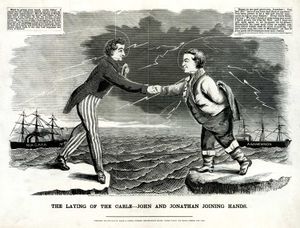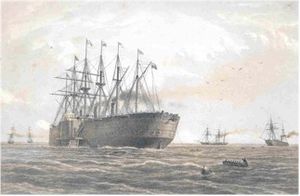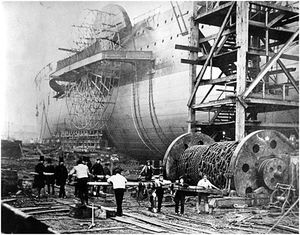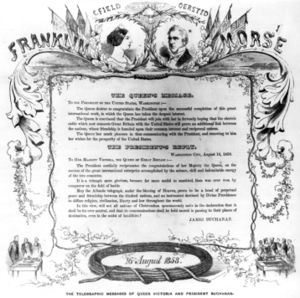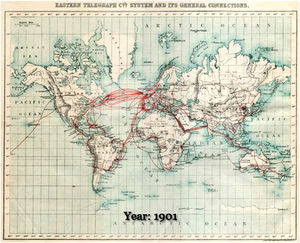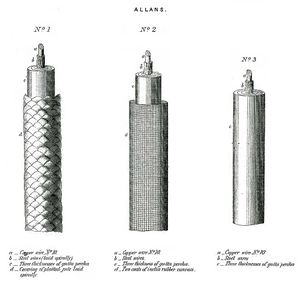Transatlantic Cable
This is a reformatted version of an article by Robert O. Woods, Fellow ASME, that originally appeared in Mechanical Engineering, July, 2011. It contains additional material from "From Gaining Weeks to Milliseconds The Transatlantic Cable", by John Vardalas, initially published in IEEE-USA's Today's Engineer, November 2010.
In August 15, 1858, Queen Victoria sent a telegram to President Buchanan. It congratulated him on the successful completion of the transatlantic cable. That had been a joint American and British effort, spearheaded from the American side by an indefatigable financier, Cyrus West Field, and on the British by a telegraph company. The message of ninety eight words took sixteen and a half hours to transmit.
In an age when anyone on the globe with a cell phone can communicate with anyone else on Earth, a single message which took hours to transmit might strike us as a quaint but unimportant event. Today it is hard to imagine the earthshaking impact this message had. The capacity to move news and data quickly over large geographic scales had profound political, military, economic, financial and social impacts. There was no shortage of speculative writing on the marvelous benefits that this new technology would bring to human interactions. One of the most tangible impacts of the telegraph was in business. The telegraph spurred the creation of nationally integrated commodity and equity markets in the United States. America’s U.S. capital trading centers, however, were still cut-off from London, then the world’s largest financial center. Information traveled across the oceans as any other commodity did — on ships. Though the Age of Steam was replacing the Age of Sail with faster vessels, moving over water was still done at a snail’s pace. So it was only natural that bold entrepreneurs and investors would start hatching plans to span the Atlantic Ocean with a telegraph cable.
In the mid-nineteenth century, before the cable was laid, there was no direct communication between continents. No message could travel faster than the fastest steamships, which required at least 10 days to make the sea voyage between America and Europe. The submarine telegraph cable reduced communication time from days to hours. A world that had seemed infinite was reduced overnight to human proportions.
In 1854, Frederic N. Gisborne, a Canadian inventor, traveled to New York to raise money for a project to link Newfoundland to the United States by telegraph. Part of this line was to include a submarine cable across Cabot Strait, the body of water which separates Newfoundland from Cape Breton, Nova Scotia. While in New York, Gisborne met Cyrus W. Field, a man who had made his fortune in papermaking, to explain his project. As Gisborne was describing the idea of a submarine cable across the Cabot Strait, Field consulted a large globe to understand the scale of Gisborne’s proposed enterprise. As he stared at Newfoundland on the globe, a much bolder enterprise came to Field. Looking at the great expanse of water separating North America from Great Britain, Field suggested to Gisborne that the telegraph line to Newfoundland be extended across the Atlantic Ocean to Britain. And so was born the 12-year project to span the Atlantic with a telegraph cable, and perhaps the greatest business and technological undertakings of that the 19th century.
Enormous sums of money had to be raised and a host of new scientific and engineering challenges had to be overcome. Could an electrical signal travel across such a long cable? Unlike the bare wires strung on poles over land, a single, long insulated cable immersed in sea water raised new scientific and technical issues about the movement of electrical currents. Large inductive and capacitive effects were discovered, and the theoretical and practical questions centered on whether these effects would seriously retard the flow of electrical signals. Great minds like Faraday and Lord Kelvin devoted their energies to finding an answer to this question. Unlike an exposed wire on a pole, the cable had to be well insulated. Werner von Siemens invented a machine to insulate wire. At the time, very little was known about the topography of the ocean floor. If the cable stretched across a deep canyon, it would eventually snap under the stress. People wondered about the effects of tides and currents on a cable as it lay on the floor. What about the composition of the sea bed. Would it destroy a cable that moved about? The greatest oceanographer of the period, U.S. naval officer Mathew Fontaine Maury, was brought in to provide data on the composition and topography of the Atlantic seabed. At the time, Maury was working on his landmark book, “The Physical Geography of the Sea.” Then there was the question of actually laying the cable across the vast expanse of the ocean. What kind of ship could hold the enormous amount of required cable? As the cable was paid out 10,000 ft down, would it snap under its own weight? New machinery had to be developed that could smoothly lay out so much cable. What would happen to the cable as the ship pitched, rolled and yawed in storms? Then there was the enormous navigational challenge of keeping the ship on the required course to match the desired track over the seabed.
Like the space program in the 20th century, the Atlantic cable extended the limits of the technology of its time. And like the space program, the American side of the effort was authorized at the highest level of government. President Franklin Pierce signed the Atlantic Cable Act in 1857 in the last day of his term.
The government's backing of the cable was analogous to the federal support for the transcontinental railroad in the 19th century. It authorized no more than two ships and seventy thousand dollars per year for a term keyed to the contractors' profits. It was taken as a given that the program would ultimately show a profit and government support would cease to be necessary.
It was a good investment. The frontiers of engineering, science, and mathematics were challenged; advances were made in electronics and physics that echo to the present day.
The Atlantic cable was unique only for its length. Underwater cables had been investigated since Morse began experimentation in 1852. By 1858 a large number of submarine cables were already in operation over shorter distances. Gulfs, harbors, lakes, and other sizable bodies of water were already spiderweb bed with them. They could be regarded as intermediate stages of development leading to the transatlantic cable.
The transatlantic cables exploited a natural product, gutta percha, that seemed to have been created especially for the job. It continued to be used for electrical insulation until it was replaced by synthetic polymers, which appeared at the beginning of the twentieth century.
The cable that carried Victoria's congratulations was laid in two sections beginning from a rendezvous point in mid-Atlantic (53 degrees north, 32 1/2 degrees west). Two converted battleships spliced their cargoes and parted laying cable; the Agamemnon provided by the British government steered east to Ireland, and the American Niagara west to Newfoundland.
The ships had made several previous attempts in which the cable broke and was lost at early stages of the process. Each time, they had to start over. The refusal to give up the project after repeated failures is a particular tribute to Cyrus Field's tenacity.
Both ships reached harbor successfully and the cable was complete in August 1858, when it was used to deliver the inaugural telegram. That was the greatest communications achievement of the time and it is important because it was the first transatlantic communication, but the cable did not last long.
During the early stages moderate voltages were used. Later, higher voltages were applied in an effort to boost signal strength and the cable insulation broke down and failed. The story of subsequent cable laying involved a ship which was the colossus of its time.
As is inevitable whenever discussing Victorian-era engineering, we encounter Isambard Kingdom Brunel. Brunel, whose middle name, however evocative, referred to nothing more than his mother's maiden name, epitomizes the wild ride that engineering was having at the time.
He began his career at the age of eighteen when his father delegated him to supervise the construction of the Thames Tunnel branch of the London Underground, the city's subway system. It ended when he created what was the largest iron ship ever constructed. Merely moving that 700-footlong vessel transversely down the ways a distance of 300 feet was a herculean engineering effort in itself.
In 1866, some 12 years after Field suggested the idea to Gisborne, and after several failures, a commercially viable transatlantic telegraph service was in place. In the end, the largest steel ship ever built, the Great Eastern, was needed for the project. The construction of this ship was in itself a great accomplishment for British technology. Britain’s industrial might also supplied all the cabling. The transatlantic cable enterprise required far more money than ever expected. Britain, the world’s largest capital market at the time, had to supply all the financing. But the principal visionary behind the project remained the American, Cyrus Field.
The ship, named the Great Eastern for the iron works that produced it, was built at its gigantic scale in the hope that it could profit from the advantage of size and carry enough coal to fuel an entire trip from England to Australia without stopping to refuel. It was initially outfitted as the ultimate in first-class luxury cruisers, although the bills were to be paid by 4,000 second- and third-class passenger s. The ship's initial cruise in September 1859, a few months after Brunel's death, involved a major steam explosion, a not uncommon occurrence among boilers of the age. Such steam explosions, epitomized by the tragic Sultana episode, were directly responsible for the development by ASME of its boiler code.
After a history as a liner that was never quite financially successful, Great Eastern, being the only ship capable of carrying the entire length of a transatlantic cable, was radically refitted in 1863. Passenger facilities were removed and three tanks varying in diameter from 50 to 75 feet were installed. These were used to transport 2,490 nautical miles of cable weighing 7,000 tons.
The project required the further installation of winches fore and aft to handle cable, as well as ancillary hardware devoted to grappling cable from the seabed and to laying marker buoys. Since the cable would sometimes have to be retrieved from depths of as much as three miles this required winches of prodigious capacity.
The ship's initial attempt to lay the cable, in 1865, ended in failure. In 1866, eight years after the first transatlantic telegram, the Great Eastern successfully laid cable from Valentia, Ireland, to a port in Newfoundland, aptly named Heart's Content, thus performing a feat that had previously required two ships.
Construction and splicing
Gutta percha, a material essentially unknown today, made the cable possible. It has properties somewhat similar to India rubber, but unlike rubber, which deteriorates after immersion in seawater, this material thrives in that environment. It has another unique property. When heated to a moderate temperature it remains plastic for some time and can be hand molded. Gutta percha was introduced to Europe in 1847 and was immediately adopted as wire insulation. In 1848 Charles Hancock used it in his patent for a machine that extruded shielded insulated wire of unlimited length. Before this, the practical length of underwater cables had been limited. They had used, among other things, wire that was insulated with rubber-impregnated cotton and contained in lead tubes. This was clearly not practical on a transatlantic scale.
A vast amount of gutta percha came to be used in cable making. A cable 2,500 nautical miles in length involved 300 tons of it, in addition to 340,000 miles of wire. In the beginning, the importation of gutta percha led to the destruction of 26 million trees per year in Borneo alone. Later, methods of harvesting the sap without destroying the tree were mandated.
It is ironic that this material, which contributed so much to human history, is forgotten today. The only current application which uses significant amounts is in dentistry, where it is used to backfill cavities.
The ability to splice cable was fundamental to the overall operation. The cable was shipped in sections that had to be spliced, and splicing was necessary in the replacement of defective portions after laying.
Faults were discovered by transmissions from the ship to a ground station. Their location was established using a sophisticated application of the ohmmeter. In the fairly frequent case of a short circuit between the conductor and the shield a knowledge of the combined resistance of the conductor and the shield per unit length allowed a conceptually simple method of locating the fault.
In the case of a break in the conductor, a more sensitive measurement of the conductance between the conductor and the braid, through the insulation, was required. This was not as easy as it might sound and the presence of sea water introduced further complications.
There is a good reason why leading experimenters like Lord Kelvin and James Clerk Maxwell were involved. Replacing or repairing a length of cable involved retrieving it from the seabed using grapples that varied from primitive to quite sophisticated. In some cases they not only captured the cable but also cut it, leaving one end to be retrieved later.
Splicing was an involved operation. The cable comprised a stranded copper conductor encased in gutta percha insulation and surrounded by a braided steel cable which also acted as a shield. This in turn was protected by additional layers of insulation and shielding, the number of layers depending on the environment. Over-wrapping usually included a fiat iron ribbon that was a barrier to marine life. All of this constituted a shell that had to be opened before the conductor itself was accessible.
The mechanical joint was called upon to transfer force of as much as 14,000 pounds and to do so without allowing the tension in the sheath to be transferred to the conductor.
Making such a joint was manpower-intensive. It took skill on the part of workers who were chosen from men who performed the same duty at cable factories. To make the joint, 90 feet of cable were brought on deck. The conductor itself was joined by rabbeting both sides of the wire for a distance of an inch or two, and soldering it using a soldering iron which was literally an iron tool which had been heated in a torch that could operate on deck in the wind. The joint was wrapped with fine wire and soldered a second time.
After this, the gutta percha insulation was restored. This exploited the unique ability of gutta percha to be molded like modeling clay and to be welded into a monolithic mass. A mechanic could hand shape the replacement, which h ad been wrapped in the form of a sheet, to make an invisible joint in the insulation. A smooth joint was vital in order to avoid discontinuities in the load-carrying braid and to protect the copper by remaining watertight.
After they made the electrical connection, the splicers rewove the load-carrying steel cable in an operation that resembled making a macrame basket. The entire process could be completed in as little as two hours. It involved reweaving for a length of 60 feet in order to successfully distribute the load.
Electrical transmission
Telegraphy was an emerging technology at the time of Victoria's message. It was to be a mature factor less than five years later, when it was used for critical communications during the American Civil War. Transmitting data through a cable more than 2,000 nautical miles in length proved to be a far more complicated problem than transmitting through the relatively short distances of terrestrial communication.
Dealing with the problem stimulated work by some of the most respected scientific minds of the time. James Clerk Maxwell, of Maxwell's Equations fame, was involved. He seems to have taken a lighthearted view of the effort. He composed a satirical ballad which he called "The Song of the Atlantic Telegraph Company."
William Thompson, later Lord Kelvin, took a more serious view and was involved from the earliest stages. He took part in the deep sea soundings that were essential to understanding the environment in which a cable would have to survive. He was also responsible for innovations like the mirror galvanometer which became an essential part of the system.
A deep understanding of electronics as it was then known was required to deal with the question of transmitting a direct current pulse through the distributed capacitance of a cable.
A great deal of new technology was born. It was, for example, found possible to transmit messages in both directions without interference by using clever circuits based on the Wheatstone bridge.
Merely making and breaking a circuit was not adequate to transmit a recognizable pulse. Closing a circuit resulted in charging a thousand-miles-long capacitor to a voltage high enough to be detected at the far end. After charging it was necessary to discharge this capacitor before it could be used to transmit another pulse.
In some cases, called "curb sending" a shorter pulse of opposite polarity would automatically be transmitted after the pulse which carried information. It also became common to use a system in which the dots were transmitted in one polarity and the dashes in the opposite.
With shorter terrestrial lines a transmission was decoded by an operator listening to the spacing of pairs of clicks made by a receiver as pulses began and ended. Such a straightforward approach was not possible with the transatlantic cable. Reception was initially done using a sensitive galvanometer in which a needle was deflected in one direction or the other depending on the polarity of the incoming pulse. Early work on this had been done in 1839 by Cooke and by Wheatstone, the inventor of the bridge circuit that bears his name.
The needle was soon replaced by Kelvin's galvanometer in which a mirror was used as an optical lever to produce a more visible deflection. This was further refined to a system in which a permanent record was produced on a moving paper tape by deflecting a hypodermic needle-like "siphon," which deposited a continuous trail of ink.
In the absence of intelligent machines, data handling necessarily put a man in the link. A land-bound telegraph operator could transmit as many as eight words per minute. By contrast, during the early days it took as much as two minutes to transmit a single Morse code character of a few dots and dashes.
Data were entered by manual keying, although the hardware rarely resembled the single straight key cherished today by radio amateurs. It was not unusual to use two keys or a compound key in which deflection in one direction produced a pulse of one polarity and deflection in the other direction produced a pulse of the opposite polarity. In some cases one key produced a dot, another produced a dash.
When not actually in use the cable was kept grounded and the fact that the Earth could be used as a return was an important early discovery. It had not been recognized at the outset.
Power was a supplied by stacks of lead-acid cells as well as by other more exotic plate and electrolyte combinations. A type very common during the Victorian era had been invented by Volta in 1799. It comprised a stack of disks of alternating copper and zinc separated by pads soaked in salt water.
In early stages of development, voltages on the order of 500 were used. It was later concluded that 60 volts was adequate. The fact that such a voltage reduction was possible was a very fortunate but late discovery by the pioneers.
In the failure of the 1858 cable, the insulation was broken down by excessive voltage. The higher potential, perhaps as much as 2,000 volts, had been tried by the aptly named and soon replaced chief electrician: Wildman Whitehouse. As happens in developmental work, he had been misled by a logical snare. If a little voltage is good, a lot looks attractive, but is not necessarily better.
Soon, other submarine cables where spanning the world’s seas and oceans. Mostly set up under British control, the global network of submarine telegraph cables added to the “command and control” capability needed to maintain an economic and political empire in which the sun never set. With its new undersea links, telegraphy also had dramatic impact on world maritime shipping. For thousands of years, when ships set out to sea to carry on long distance trading, it would be a long time before they returned, often months and sometimes more than a year. During this time, the there was no communication with the ship. The owners had no knowledge of the fate of their ship. Merchants had no way of knowing the commercial fate of their cargoes until the ship returned home. With no knowledge of the quality and quantity of goods arriving on inbound ships, buyers and sellers negotiated in relative ignorance. With submarine cables, traders had a more realistic understanding of the availability and pricing of commodities and products in the markets around the world. Better knowledge also allowed the shipping companies to redirect ships in response to changing opportunities in different parts of the world.
The rate of communication over the submarine telegraph cables began with 8 words per minute and improved quickly to 17 words per minute. At $5 a word, this mode of communication was very expensive. Based on the 1880 U.S. census data, the average skilled worker would have had to work one to two full days to send one word across the Atlantic. By today’s standards, these communication speeds are ludicrously slow and outrageously expensive. And yet, in the 19th century, the transatlantic cable provided an enormous economic and political advantage to those able to afford it. Hibernia Atlantic’s Express Project, with its 5 millisecond advantage, does show that timely access to intelligence still commands a premium price.
Additional Readings
Landing of the Transatlantic Cable, 1866 - IEEE Milestone
Doug Cameron and Jacob Bunge, “Underwater Options: Trans-Atlantic Cable Targets High-Frequency Traders”, The Wall Street Journal, 1 October 2010, p. C3.
Bern Dibner, The Atlantic Cable, (Norwalk, Conn.: Burndy Library Inc., 1959)
Daniel Headrick and Pascal Griset, “Submarine Cables: The Business and Politics, 1838 – 1939,” Business History Review, 75 (Autumn 2001), pp. 543 – 578.
Byron Lew and Bruce Cater, “The Telegraph, coordination of tramp shipping, and growth in world trade, 1870 – 1910”, European Review of Economic History, 10 (2006), pp. 147 – 73.
Ronnie Phillips, “Digital Technology and Institutional Change From the Gilded Age to Modern Times: The Impact of the Telegraph and the Internet”, Journal of Economic Issues, 2 (June 2000), pp. 267 – 89.
